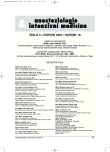-
Články
Top novinky
Reklama- Vzdělávání
- Časopisy
Top články
Nové číslo
- Témata
Top novinky
Reklama- Kongresy
- Videa
- Podcasty
Nové podcasty
Reklama- Kariéra
Doporučené pozice
Reklama- Praxe
Top novinky
ReklamaVývoj péče o průchodnost dýchacích cest
The evolution of airway management
This article describes the most important steps of the evolution of the contemporary methods of airway management in anaesthesiology and critical care. In the 19th century the principal method of safeguarding the open airway was tracheostomy, cannulation of the trachea and supralaryngeal tamponade prior to the beginning of general anaesthesia and surgery. Trendelenburg (1869) was the first one to use an inflatable cuff for sealing the tracheostomy cannula. MacEwen introduced inserting the tracheal tube into the larynx through the mouth in 1878. The method was improved by Maydl in Prague (1893). Magill and Rowbotham developed a well usable method of endotracheal intubation and nasotracheal blind intubation in the 1920s. Guedel developed convenient types of nasal and oral airways in the same years. He and Waters reintroduced the cuffed rubber endotracheal tube. Macintosh contributed to the technique of endotracheal intubation by introducing the curved laryngoscope blade in 1943. Thanks to the introduction of the intravenous anaesthetic thiopentone by Lundy and Waters in 1934, and muscle relaxants by Griffith in 1942, it was possible in the 1950s to develop a method for the induction of general anaesthesia with endotracheal intubation still used today.
Key words:
laryngoscopy – tracheal intubation – thiopentone – muscle relaxants
Autoři: J. Pokorný
Působiště autorů: Komise pro historii oboru České společnosti anesteziologie, resuscitace a intenzivní medicíny ČLS JEP
Vyšlo v časopise: Anest. intenziv. Med., 18, 2007, č. 3, s. 181-186
Kategorie: Historie oboru
Souhrn
Autor uvádí nejdůležitější vývojové stupně, které předcházely soudobým standardním pracovním postupům k spolehlivému zajištění volné průchodnosti dýchacích cest v anesteziologii a při resuscitační péči. V 19. století byla hlavní metodou pro jejich zajištění tracheostomie, kanylace trachey a tamponáda nad vchodem do hrtanu před zahájením celkové anestezie a operace. Trendelenburg (1869) použil poprvé k utěsnění kanyly nafukovací těsnicí manžetu. MacEwen jako první zavedl do laryngu tracheální rourku ústy (1878). Jejich postup zdokonalil K. Maydl v Praze (1893). Magill a Rowbotham vypracovali ve 20. letech 20. století dobře využitelnou metodu endotracheální intubace při laryngoskopii a nazotracheální intubace poslepu. Guedel navrhl ve stejné době plně vyhovující tvar ústních a nosních vzduchovodů a společně s Watersem zavedli pryžovou manžetovou tracheální rourku. Macintosh v roce 1943 přispěl zásadně ke zlepšení techniky laryngoskopie před intubací trachey uvedením laryngoskopu se zahnutou lžící. Díky zavedení nitrožilní anestezie thiopentalem J. Lundym a R.Watersem v roce 1934 a svalových relaxancií H. Griffithem v roce 1942 bylo možno vypracovat v 50. letech minulého století dodnes plně vyhovující šetrný způsob úvodu do celkové anestezie s endotracheální intubací.
Klíčová slova:
laryngoskopie – intubace trachey – laryngoskop – thiopental – svalová relaxancia
Štítky
Anesteziologie a resuscitace Intenzivní medicína
Článek vyšel v časopiseAnesteziologie a intenzivní medicína
Nejčtenější tento týden
2007 Číslo 3- Jak souvisí postcovidový syndrom s poškozením mozku?
- Globální doporučené postupy pro léčbu mukormykózy zdůrazňují urgentnost zásahu
- Perorální antivirotika jako vysoce efektivní nástroj prevence hospitalizací kvůli COVID-19 − otázky a odpovědi pro praxi
- Léčba akutní pooperační bolesti z pohledu ortopeda
- Účinnost kombinace diklofenak/orfenadrin v terapii poruch pohybového aparátu
-
Všechny články tohoto čísla
- Ovlivnění hemodynamiky během operací aneurysmat abdominální aorty užitím metody akutní normovolemické hemodiluce
- Časná resuscitace septického šoku na různé úrovně arteriálního tlaku
- Objective: The optimal target mean arterial pressure (MAP) in the resuscitation of septic shock is undetermined. The aim of this study was to assess the effect of different levels of MAP on splanchnic organ perfusion/ function and lactate metabolism. Desi
- Rozšířený imunologický profil v prvních dnech pobytu a prognóza nemocných dlouhodobě hospitalizovaných na JIP
- Aktivace monocytů během prvních dnů pobytu a přežití u heterogenní skupiny nemocných vyžadujících dlouhodobou intenzivní péči
- Helium a jeho význam v současné medicíně
- Vývoj péče o průchodnost dýchacích cest
- Anesteziologie a intenzivní medicína
- Archiv čísel
- Aktuální číslo
- Informace o časopisu
Nejčtenější v tomto čísle- Helium a jeho význam v současné medicíně
- Vývoj péče o průchodnost dýchacích cest
- Ovlivnění hemodynamiky během operací aneurysmat abdominální aorty užitím metody akutní normovolemické hemodiluce
- Objective: The optimal target mean arterial pressure (MAP) in the resuscitation of septic shock is undetermined. The aim of this study was to assess the effect of different levels of MAP on splanchnic organ perfusion/ function and lactate metabolism. Desi
Kurzy
Zvyšte si kvalifikaci online z pohodlí domova
Autoři: prof. MUDr. Vladimír Palička, CSc., Dr.h.c., doc. MUDr. Václav Vyskočil, Ph.D., MUDr. Petr Kasalický, CSc., MUDr. Jan Rosa, Ing. Pavel Havlík, Ing. Jan Adam, Hana Hejnová, DiS., Jana Křenková
Autoři: MUDr. Irena Krčmová, CSc.
Autoři: MDDr. Eleonóra Ivančová, PhD., MHA
Autoři: prof. MUDr. Eva Kubala Havrdová, DrSc.
Všechny kurzyPřihlášení#ADS_BOTTOM_SCRIPTS#Zapomenuté hesloZadejte e-mailovou adresu, se kterou jste vytvářel(a) účet, budou Vám na ni zaslány informace k nastavení nového hesla.
- Vzdělávání



